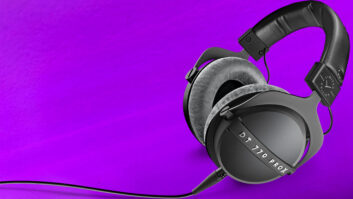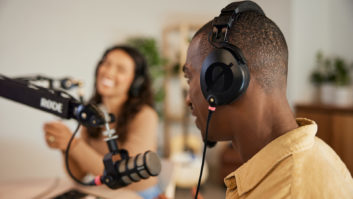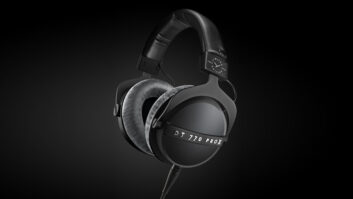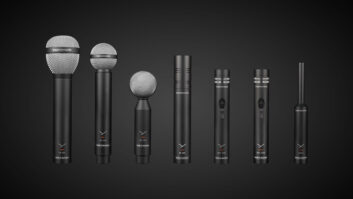Beyerdynamic’s MCD 100 (cardioid) and MCD 101 (omni) mics-which combine conventional condenser capsules with built-in-the-housing preamps and 24-bit A/D conversion-bring several issues to the table. Chiefly, with the number of “favorite” microphones and boutique mic preamps in the market, how dare Beyer bring to market a condenser mic that you can’t use with your latest/greatest mic preamp, analog compressor or EQ? Well, I’ll tell you how. After years of manufacturing quality mics, Beyer is still interested in advancing the state of the art of microphone technology.
of course, the state of the art doesn’t come cheap. The MCD 100 cardioid or MCD 101 omni microphone list at $2,500 each. The MPD 200 power supply and DSP box cost $1,599. So, the full system comes in at $4,100 for a mic, mic preamp and A/D converter with a default sample rate of 48 kHz. The MPD 200 also features word clock in/out ports, so the system can be master or slave to other word- clocked devices. My orban Audicy DAW has word clock, but I found no problems simply plugging into the AES/EBU port of it or a Panasonic SV-3900 DAT machine without word clock. With word clock from the Audicy, I could shift the MCD 100 sample rate to 32/44.1/48 kHz with no problems.
In addition to handling word clock, the MPD 200 takes the input from one or two MCD 100 (or MCD 101) mics and allows their gain to be altered before its 24-bit digital output. Buttons on the side of the MPD 200 let you choose a gain range of -20 dB, -10 dB, 0 dB and upwards to +36 dB in 6dB increments. The mics and their A/D converters are 22-bit devices. I contacted Kai Konrath at Beyer in Germany to get the straight dope on the bits. “The 24-bit ADC was especially designed for MCD 100. It has a true dynamic range of 22-bit and is pretty smart compared to other commercially available converters,” he said. “The ADC inside the mic is a complex containing several chips (stereo ADC, DSP and analog components). It is patented and licensed under 24-bit TrueMatch system from Stage Tec. Inside the DSP, 32-bit resolution is performed; the MCD output resolution is 24-bit.”
Then there’s the issue of digital cabling. Konrath said he always does demonstrations with 1,000 feet of AES3 cable (Mogami 3080-110 ohm) between MCD and the power supply, and that same length can be used to the AES3 interface. He said using 500 feet of “analog” multicore cable at 85 ohms in a German o.B. truck wasn’t a problem either.
There’s another little trick with a feedback circuit inside the mic that keeps it from clipping. The capsule will fold, but Konrath said the mic will not clip: “Peaks over a set SPL mean just a little limiting and not terrible clipping (multiplication will be decreased for the actual samples). This saves a lot of time and stress in recording sessions.”
Asked about the intended audience for the company’s digital mics, a representative at Beyer’s U.S. headquarters said, “We’ve seen this mic being accepted by people coming into audio from the digital and computer side. They’re primarily users who get the audio into the box and use software and DSP to make their changes afterwards.” Suddenly I came to the chilly realization that, as we proceed into the digital realm, we will leave more and more of our analog tools behind. It’s true, but I’m still experiencing some mid-level denial. However, it’s true that there are an increasing number of “Pro Tools people” who have never rocked a reel of tape and never used a razor blade to cut a piece of tape.
So with a lot of R&D money poured into the converters, how does the mic sound? Well, it sounds pretty good. The 31/44-inch diameter, single-sided capsule is the same as that used in Beyer’s MC 834. It’s fairly linear, much like a calibration mic. Most calibration mics, however, rarely win accolades because, without the presence curve applied, they sound a bit dull on top. While not dull, without EQ, the MCD 100 doesn’t have a lot of air.
I started my evaluation with my voice using the 16-bit AES/EBU input to my orban Audicy DAW. The first thing I noticed was the slight delay caused by the minute amount of time the signal is delayed while going through the A/D and D/A converters. When moving in from a distance, at about 2.5 feet from the mic, there was a noticeable solidity, although the gain was low. I pumped the gain on the MPD 200 box all the way to +36 and moved in. As I got to within 6 inches, my voice thickened, sounding really meaty. I found that backing the MPD 200 off to +30, +24 and all the way down to +18 resulted in lower gain and reduced thickness while the peaks remained as high as they had been with the +36 setting.
I’m assuming that the thickness was the overload protection circuit working. There were no pumping or other compressor-like by-products. The lo-fi waveform display on my Audicy, at close range with +36dB gain setting, revealed a denser waveform than any other mic I have ever plugged into the workstation. That density seemed appropriate given the density of its sound and the overload protection voodoo going on. So the gain structure acts sort of like a digital compressor. Want a fatter sound? Pump up the gain.
I recorded some tracks and spent some time with the Audicy’s digital EQ making the MCD 100 sound similar to a Neumann TLM 103. I was never able to get an exact match but got close by pulling out a couple dB at 103 Hz and a few more at 584 Hz. The TLM 103 had more sparkle and cut. Based on what I heard, the MCD 100 would work well on voice and particularly well on any edgy source, such as soprano, strings, banjo, sax or bagpipe. The low-end response also indicates it may be very useful for bass and drums
What happens if you just don’t like the mic’s EQ curve and don’t want to use the internal digital EQ on your system? According to Konrath, Beyer can burn custom EPRoMs for different curves. Though no one has yet asked for them, he thought they could be done for about $900 each. This opens up the possibility of microphone modeling. A little DSP, a little digital EQ and you could conceivably end up with a mic locker on chips. Better yet, a $900 computer program running on a laptop that interfaces with the mic could allow the creation of custom curves that could be flash RAMed as desired.
Comparing self-noise was a bit challenging, given the digital output of the mic, but after I got relatively equal levels between the MCD 100 and TLM 103, the MCD 100 had a bit more self-noise. Beyer sets self-noise of the MCD 100 at 15 dBA. Fairly respectable by today’s digital noise floor standards but above that of the Neumann TLM 103’s 7 dBA. The capsule in the MCD 100 is at least as prone to popping as the TLM 103. Its cardioid pattern is extremely generous with very little off-axis coloration and a slight LF bump off the rear lobe.
I can’t quite put my finger on it, but there’s something different-sounding about the MCD 100. It is, perhaps, a directness that is particularly not edgy. If the self-noise of this mic were down around 10 dBA, it would be scary instead of simply impressive.
Given that the Beyer MCD 100 and MCD 101 represent analog preamp and A/D heresy, I expect many to damn them before giving them a chance. Regardless, as these are the first of many digital microphones, I commend Beyer for making a gutsy move to bring them to market. It’s refreshing to see a company advancing the state of the art when so many others are trying to figure out how to use cheap imported condenser capsules to make microphones that sell for less than the suspension mounts of most of today’s studio-standard microphones. If they haven’t received an award for their work on this system, they should.
Beyerdynamic, 56 Central Ave., Farmingdale, NY 11735; 516/293-3200; fax 516/293-3288; www.beyerdynamic.com.
Reach Ty Ford at www.tyford.com.






